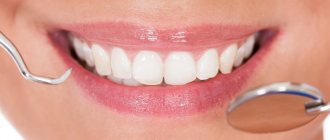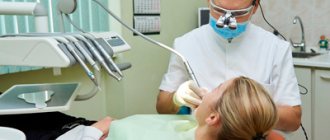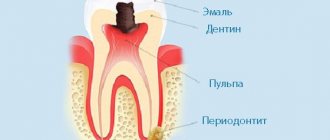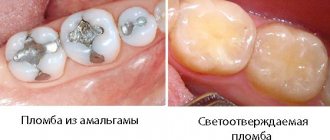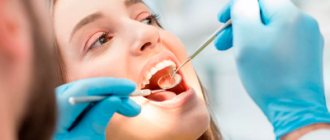Typically, toothache occurs during the 3rd and 4th stages of carious lesions. However, it is not always the cause of this symptom. There are times when a tooth hurts, but there is no caries. Other diseases, not just dental ones, can be a source of pain. Let's find out why a tooth hurts when there is no carious process.
In this article
- Causes of toothache without caries
- Other causes of tooth pain: non-dental diseases
- Diseases of internal organs and toothache
- Diagnosis for toothache
- Prevention
First, we’ll tell you how teeth hurt due to caries. At the first stage there is no pain. The pathological process is accompanied by the formation of a white spot - an area of enamel demineralization. It appears as a result of the proliferation of bacteria that corrode the enamel surface and make it loose. At this stage, caries no longer manifests itself. Only in the second stage does the patient experience pain after eating sweet foods. However, as soon as he brushes his teeth or rinses his mouth, the discomfort disappears.
At the third stage, the tooth hurts when exposed to not only sweet, but also sour foods. The pain also makes itself felt when there is a temperature difference, when a person drinks cold or hot water, breathes frosty air, brushes his teeth, etc. After eliminating the irritant, the symptom disappears.
The fourth stage of caries is characterized by deep penetration of pathology into dentin. It is separated from the pulp by a thin septum. Pain occurs whenever a tooth comes into contact with external factors. If it appears suddenly even at rest, most likely, pulpitis develops - inflammation of the dental nerve, or pulp. However, this is a different disease, accompanied by toothache. Let's list all the pathologies with this sign.
Causes of toothache without caries
If a tooth hurts, but there is no caries, the cause of the symptom should first be sought in other dental diseases. Painful sensations to one degree or another are characteristic of the following pathologies:
- Pulpitis is an inflammatory process that affects the nerve tissues of the tooth, which are located inside the dentin. It usually develops due to untreated tooth decay. It can also occur under a filling. Inflammation makes itself felt by spontaneous pain, which is prolonged. The pain is sharp and acute, and it is usually not possible to eliminate it with the help of analgesics. The tooth hurts very badly at night. If pulpitis becomes chronic, the pain becomes aching, but not so intense. As a rule, because of this disease the pulp has to be removed. The tooth becomes dead and noticeably darker.
- Periodontitis is inflammation of the tooth root. Occurs on intact (untreated) teeth, after trauma, due to the spread of a cyst, as a result of infection, or under a filling. The pain appears during eating, and during exacerbation, it radiates to neighboring teeth. The pain is aching in nature, and gumboil may develop. Acute purulent periodontitis is accompanied by a general deterioration in health, weakness and fever.
- Periodontitis is an inflammatory lesion of the tissues surrounding the tooth. With this disease, periodontal pockets are formed and gum recession is observed. Because of this, teeth become more sensitive and react painfully to external stimuli. Other signs of periodontitis include itchy gums, bleeding and bad breath. The tooth hurts especially badly when pressing and chewing food, and sometimes it becomes loose. The advanced form of the disease is treated surgically.
- Gingivitis is an inflammatory disease of the gums that causes pain in one or more teeth. If suppuration begins in the gum pockets, bad breath appears, the tooth begins to loosen, and the gums bleed. Pain occurs suddenly, for example, during chewing food, especially hot, cold and sour.
- A dental cyst is a new formation between the tooth root and the jaw bone; it looks like a sac filled with pus. The disease is accompanied by aching pain, the tooth hurts especially severely when pressed or exposed to hot food or drinks. A cyst can be detected using radiography. It is treated surgically. After removal, pain, increased sensitivity and swelling of the gums may persist for some time.
- Impacted wisdom tooth. Unerupted “eights” often begin to grow to the side; they often put pressure on neighboring teeth, causing pain. This process is also accompanied by inflammation of the gums. The pathology is easy to diagnose by the location of the pain - behind the last molar, that is, at the very edge of the jaw.
Also, toothache is accompanied by non-carious enamel lesions, for example, erosion, increased abrasion or dysplasia. The tooth hurts when exposed to sour or sweet foods, during contact with a toothbrush or dental instrument. During differential diagnosis, the doctor must distinguish caries from the listed diseases and prescribe appropriate treatment. It is almost impossible to accurately determine the pathology only by the nature of the toothache.
Tooth hurts after nerve removal and filling
Only a dentist after an examination will help you figure out why a tooth hurts after removing a nerve and filling its canals. Treating teeth on your own without a diagnosis is highly discouraged.
In dental practice, the procedure for treating tooth canals by removing a nerve is a rather complex manipulation. Cases of medical error are common. They are fraught with various complications, in which the filled tooth continues to hurt.
The main reason why a “dead tooth” (without a nerve) is bothersome is:
- removal of the filling material beyond the apex of the tooth - this occurs due to incorrect definition
- working tooth length;
- the doctor filled the canal incorrectly;
- a tool broke off in the canal;
- root perforation of the tooth;
- If your tooth aches, you may be allergic to the filling material.
It is worth considering that a tooth under a filling can hurt even without a nerve. After all, during the extraction procedure, only a small part of it is removed from the root canal, which branches off from the main nerve trunk. In addition, when removing and filling canals, dental tissues are damaged. When an anesthetic is applied to a tooth, pain is not felt; it begins to be felt after the anesthesia wears off. Such painful sensations are called post-filling.
After removal of a nerve, neighboring teeth can often be bothered, but it seems as if it is the treated tooth that is hurting. An experienced doctor will examine the dentition to identify and eliminate this problem. However, it is worth sounding the alarm when the nerve has been removed for a long time, and the tooth continues to hurt - this symptom may signal the development of chronic pulpitis or periodontitis.
Other causes of tooth pain: non-dental diseases
If a dental examination is inconclusive, you need to pay attention to the areas adjacent to the oral cavity. The cause of toothache may be hidden in other pathologies: sinusitis, otitis, migraine, trigeminal neuralgia and salivary stones. Let's briefly look at the symptoms of each of these diseases and find out why they cause toothache.
Sinusitis is inflammation in the area of the maxillary sinuses, occurring in acute or chronic form. The disease is characterized by pressing, throbbing pain and colic in the upper jaw. Pain in the cheekbone area and at the roots of the upper teeth is also possible. Often the patient has a headache or part of the face, a burning sensation in the eyes, swelling of the eyelids and other symptoms.
Otitis is an inflammation in the ear area, accompanied by pain, which in nature resembles the pain associated with advanced caries. The pathology can occur in chronic, acute, purulent or catarrhal form. Each of them has its own specific symptoms. With otitis media, the entire jaw may hurt, the pain radiates to the temple and eyebrow, and the body temperature rises. The pain intensifies while eating.
Migraine is a form of headache that is usually localized to one side of the head. In this case, a person often has pain in his upper teeth or the entire upper jaw, and there is pain in the temple and behind the eye socket. The pain intensifies with sudden movements or bright light. Additional symptoms of migraine include nausea and vomiting. There can be many reasons for this pathology; usually you need to undergo a comprehensive examination.
Trigeminal neuralgia is a chronic disease that manifests itself as paroxysmal and shooting pain, usually from the jaw. Discomfort appears suddenly, even at rest, but can intensify when you press your hand on your face. There is no aching or prolonged toothache with this pathology.
Salivary stone disease is a pathology in which a dense mineral formation is formed in the salivary gland, similar in structure and composition to tartar. This disease is characterized by symptoms such as frequent pain in the teeth when eating, an unpleasant taste in the mouth, headaches, increased body temperature up to 37.5 ° C, general weakness, dry oral mucosa, etc. Patients also complain of feeling swelling in the part of the jaw where the stone appeared. The disease can occur in acute and chronic form. The causes of its occurrence are varied and are usually not directly related to the oral cavity.
Depending on the nature of the origin of the pain, the patient is sent to one or another specialist: otolaryngologist, neurologist, etc.
Nature of pain
The following pain characteristics are important for diagnosis:
- appears in response to irritants - mechanical (when cleaning, touching), thermal (cold, hot), chemical (sweet, sour);
- spontaneous - for no apparent reason;
- short-term – passes within 10-15 minutes;
- prolonged pain, difficult to respond to painkillers, often at night, preventing sleep;
- pulling, aching;
- sharp, cutting;
- with irradiation into adjacent teeth, into the teeth of the opposite jaw, along the nerve trunk, into the eye, into the ear;
- without irradiation with a clear sensation of the causative tooth;
- when biting during or without eating.
Diseases of internal organs and toothache
The exact cause of pain can only be determined during an examination - dental or comprehensive. However, experienced doctors know about the relationship between painful or uncomfortable sensations in the mouth and pathologies of internal organs. If pain is localized in one or another part of the jaw, the doctor may suspect certain diseases of the kidneys, spleen, stomach, etc. Of course, one symptom is not enough to make a diagnosis, but there may be a reason for additional examination.
Toothaches and changes in internal organs can be correlated as follows:
- Respiratory tract diseases (pneumonia, polyps, bronchitis) and intestinal dysfunction cause pain in the premolar area.
- Pathologies of the genitourinary system are sometimes accompanied by pain in the front teeth - incisors.
- Malfunctions of the spleen, stomach or excretory system are transmitted to the molars.
- The cardiovascular system is closely related to the “eights” - wisdom teeth.
- If the fang hurts for no obvious reason, it is worth checking the bile ducts.
- If tartar forms, you can be examined for diseases of the endocrine system.
Many people immediately take painkillers when they experience toothache or other pain. Today, quite strong drugs are produced that can relieve almost any pain, but they only eliminate the symptom. The disease itself and its causes cannot be cured with analgesics. If the etiology of toothache is not established, it will progress further. As a result, the risk of complications increases. If you have a toothache or other unpleasant symptoms in the oral cavity, immediately make an appointment with your dentist.
Tooth hurts after root canal filling
Dental clinic patients are often concerned about the question of why their tooth hurts after inserting filling material into the tooth canal after removal of the nerve. Since any intervention in the body has its consequences, toothache is an “echo” of the filling procedure.
The most common reasons for a tooth to ache after root canal filling are:
- burns and overdrying of dentin;
- allergic reaction to filling material;
- depressurization of the seal;
- change in bite;
- exposure to polymerization lamps;
- shrinkage of the filling.
After the procedure, the dentist usually advises you on how long the tooth under the filling hurts. However, if you feel increasing pain in a filled tooth for more than 2 weeks, you should urgently consult a doctor. Such pain can occur when an instrument breaks off in the canal, root perforation, or improper treatment of pulpitis.
Diagnosis for toothache
First, the dentist will conduct a visual examination of your mouth. Usually, to identify caries, if it does not develop on the tooth root or under the gum, the doctor simply needs to examine the diseased tooth. In some cases, he uses special indicators that color the areas of enamel affected by the carious process blue or purple. The doctor may also prescribe radiography, laser diagnostics, electroodontometry and transillumination. If dental pathologies are excluded, you will need to go to other specialists - an otolaryngologist, a surgeon, a neurologist or a therapist.
Diagnosis and treatment
If a tooth aches without signs of caries, contact a dental clinic. Only a specialist can exclude the possibility of carious lesions and make an accurate diagnosis. Typically, diagnosis includes examination and x-rays.
The treatment regimen is drawn up taking into account the clinical picture. Treatment may be directed:
- for remineralization of enamel,
- elimination of factors that provoke pain,
- restoration of the integrity of the dental unit,
- decreased tooth sensitivity,
- strengthening gums and eliminating inflammation.
The doctor will provide more detailed information about treatment during the consultation.
Prevention
There is no specific prevention of toothache. However, there are preventive measures that allow you to avoid certain diseases, including caries. To prevent its development, you need to carefully monitor oral hygiene, eat less sweet foods, stop smoking and visit the dentist's office twice a year.
If the toothache does not go away even after taking painkillers, you should immediately go to the clinic. Treating dental diseases with folk remedies is useless or even dangerous. The risk of pathology progression and complications increases.
Dental injuries and oral diseases
Sometimes tooth pain occurs due to injury (root fracture, bruise), malocclusion, cyst or oral cancer. But the most common cause is considered to be increased sensitivity of the teeth. Painful sensations occur when eating cold or hot food, as well as acidic drinks and foods.
To avoid dental problems, dentists recommend practicing good oral hygiene, brushing your teeth regularly and visiting the dental office. The prevention of dental diseases also plays an important role: removal of plaque and tartar, fluoridation and remineralization of the dentition and, of course, sealing of fissures. You can go through all these procedures at. Let's fight together for the beauty and health of your smile!
